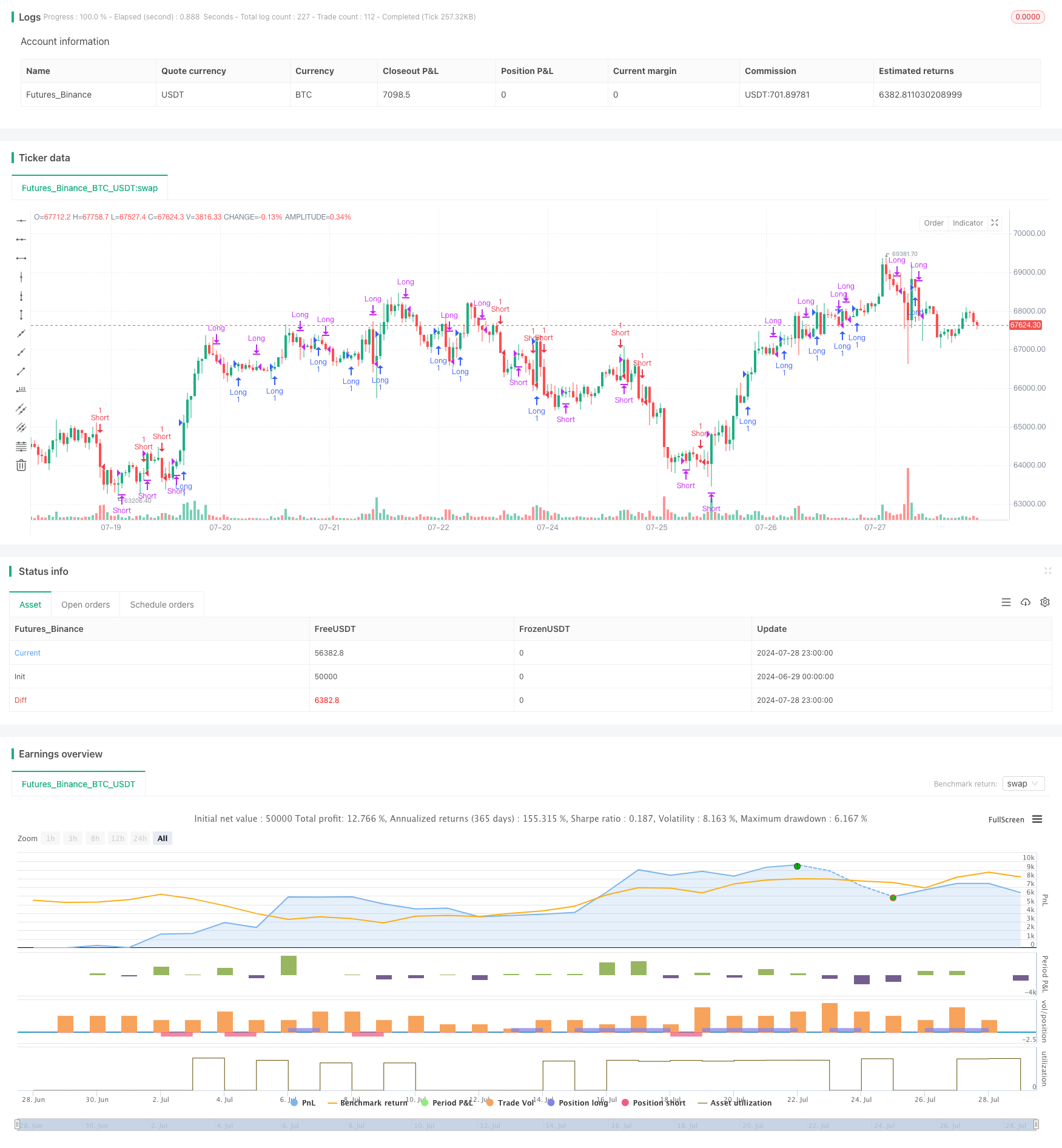
概述
高级复合均线与市场动量趋势捕捉策略是一个结合了多重技术指标的复杂交易系统。该策略主要利用Hull移动平均线(HMA)、一目均衡图(Ichimoku Kinko Hyo)和唐奇安通道(Donchian Channel)等指标,通过分析价格动量和趋势强度来识别潜在的交易机会。这种方法旨在捕捉市场的主要趋势,同时过滤掉短期的市场噪音,从而提高交易的准确性和盈利能力。
策略原理
该策略的核心是通过比较不同周期的Hull移动平均线来判断市场趋势。Hull移动平均线是一种经过改进的加权移动平均线,能够更快速地响应价格变化,减少滞后性。策略使用两个不同周期的Hull移动平均线(n1和n2)进行交叉比较,以确定趋势方向。
同时,策略还结合了一目均衡图的多个组成部分,包括转换线(Tenkan-sen)、基准线(Kijun-sen)、先行带A(Senkou Span A)、先行带B(Senkou Span B)和滞后线(Chikou Span)。这些指标共同提供了对市场趋势、支撑和阻力水平的全面分析。
此外,策略还使用了唐奇安通道来计算一目均衡图中的某些组件,这有助于识别价格的波动范围和潜在的突破点。
交易信号的生成基于以下条件的组合:
多头入场条件:
- n1 > n2 (Hull移动平均线指示上升趋势)
- 收盘价 > n2
- 收盘价 > 滞后线
- 收盘价 > 先行带高点
- 转换线 >= 基准线 或 收盘价 > 基准线
空头入场条件:
- n1 < n2 (Hull移动平均线指示下降趋势)
- 收盘价 < n2
- 收盘价 < 滞后线
- 收盘价 < 先行带低点
- 转换线 <= 基准线 或 收盘价 < 基准线
多头平仓条件:
- n1 < n2 或
- 收盘价 < n2 或
- 转换线 < 基准线 或
- 收盘价 < 转换线 或
- 收盘价 < 基准线 或
- 收盘价 < 先行带高点 或
- 收盘价 < 滞后线
空头平仓条件:
- n1 > n2 或
- 收盘价 > n2 或
- 转换线 > 基准线 或
- 收盘价 > 转换线 或
- 收盘价 > 基准线 或
- 收盘价 > 先行带低点 或
- 收盘价 > 滞后线
这种多重条件的组合旨在确保只有在多个技术指标一致指向同一方向时,才会触发交易信号,从而提高交易的可靠性。
策略优势
多指标融合: 通过结合Hull移动平均线、一目均衡图和唐奇安通道,策略能够从多个角度分析市场,提高信号的可靠性。
趋势跟踪能力: Hull移动平均线的使用使得策略能够快速捕捉到趋势的变化,而一目均衡图则提供了对中长期趋势的洞察。
噪音过滤: 多重条件的设置有助于过滤掉市场中的短期噪音,只有在多个指标共同确认时才会产生交易信号。
动态适应性: 策略的参数可以根据不同的市场条件进行调整,使其能够适应不同的交易品种和时间周期。
风险管理: 通过设置明确的入场和出场条件,策略有助于控制风险,避免在不利的市场环境中持续亏损。
全面的市场视角: 一目均衡图提供了对未来市场可能走向的预测,有助于traders做出更加前瞻性的决策。
客观性: 策略基于明确的数学模型和技术指标,减少了主观判断对交易决策的影响。
策略风险
过度优化风险: 策略使用了多个参数,如果过度优化这些参数以适应历史数据,可能会导致未来表现不佳。
滞后性风险: 尽管Hull移动平均线减少了滞后性,但所有基于移动平均线的策略仍然存在一定程度的滞后,可能导致在趋势反转时出现较大回撤。
假突破风险: 在横盘市场中,策略可能会产生多个假突破信号,导致频繁交易和不必要的成本。
市场环境依赖: 该策略在强趋势市场中表现较好,但在震荡市场或快速反转的市场中可能表现不佳。
参数敏感性: 策略的性能可能对参数设置非常敏感,不同的参数组合可能导致显著不同的结果。
计算复杂性: 策略使用了多个复杂的技术指标,这可能导致在实时交易中出现延迟或执行问题。
过度交易风险: 多重条件的设置虽然提高了信号的可靠性,但也可能导致交易机会的减少,影响整体收益。
策略优化方向
动态参数调整: 实现参数的动态调整机制,根据市场波动性和趋势强度自动调整Hull移动平均线和一目均衡图的参数,以适应不同的市场环境。
引入机器学习算法: 利用机器学习技术,如支持向量机(SVM)或随机森林,来优化信号生成过程,提高预测准确性。
整合基本面分析: 在技术分析的基础上,引入基本面因素,如经济数据发布或公司财报,以提高交易决策的全面性。
改进风险管理: 实现动态的止损和利润目标设置,根据市场波动性和趋势强度自动调整风险管理参数。
多时间框架分析: 引入多时间框架分析,确保交易方向与更大的时间框架趋势一致,减少逆势交易的风险。
波动率过滤: 添加波动率指标,如ATR(平均真实范围),在低波动率期间减少交易频率,避免在不明确的市场环境中交易。
情绪分析整合: 引入市场情绪指标,如VIX恐慧指数或社交媒体情绪分析,以捕捉市场参与者的心理状态,提高交易时机的把握。
优化计算效率: 使用更高效的算法或并行计算技术来优化策略的计算过程,减少实时交易中的延迟。
总结
高级复合均线与市场动量趋势捕捉策略是一个综合性的交易系统,通过融合Hull移动平均线、一目均衡图和唐奇安通道等多个技术指标,旨在准确捕捉市场趋势并提供可靠的交易信号。该策略的优势在于其多角度分析市场的能力,以及对趋势变化的敏感性。然而,它也面临着过度优化、市场环境依赖等风险。
通过不断优化和改进,如引入动态参数调整、机器学习算法和多时间框架分析等,该策略有潜力成为一个更加稳健和适应性强的交易系统。未来的发展方向应该注重提高策略的灵活性和智能化,以更好地应对不断变化的市场环境。
总的来说,这个策略为交易者提供了一个强大的工具,用于捕捉市场趋势和管理风险。但是,就像所有的交易策略一样,它并不是万能的。交易者在使用这个策略时,仍然需要结合自己的市场洞察力和风险管理原则,以实现长期稳定的交易业绩。
//@version=4
strategy("Private Strategy TradingView", shorttitle="Private Strategy TradingView", overlay=true)
keh = input(title="Double HullMA", type=input.integer, defval=12, minval=1)
n2ma = 2 * wma(close, round(keh / 2))
nma = wma(close, keh)
diff = n2ma - nma
sqn = round(sqrt(keh))
n2ma1 = 2 * wma(close[1], round(keh / 2))
nma1 = wma(close[1], keh)
diff1 = n2ma1 - nma1
sqn1 = round(sqrt(keh))
n1 = wma(diff, sqn)
n2 = wma(diff1, sqn)
TenkanSenPeriods = input(9, minval=1, title="Tenkan Sen Periods")
KijunSenPeriods = input(24, minval=1, title="Kijun Sen Periods")
SenkouSpanBPeriods = input(51, minval=1, title="Senkou Span B Periods")
displacement = input(24, minval=1, title="Displacement")
donchian(len) => avg(lowest(low, len), highest(high, len))
TenkanSen = donchian(TenkanSenPeriods)
KijunSen = donchian(KijunSenPeriods)
SenkouSpanA = avg(TenkanSen, KijunSen)
SenkouSpanB = donchian(SenkouSpanBPeriods)
SenkouSpanH = max(SenkouSpanA[displacement - 1], SenkouSpanB[displacement - 1])
SenkouSpanL = min(SenkouSpanA[displacement - 1], SenkouSpanB[displacement - 1])
ChikouSpan = close[displacement - 1]
longCondition = n1 > n2 and close > n2 and close > ChikouSpan and close > SenkouSpanH and (TenkanSen >= KijunSen or close > KijunSen)
if (longCondition)
strategy.entry("Long", strategy.long)
shortCondition = n1 < n2 and close < n2 and close < ChikouSpan and close < SenkouSpanL and (TenkanSen <= KijunSen or close < KijunSen)
if (shortCondition)
strategy.entry("Short", strategy.short)
closelong = n1 < n2 and (close < n2 or TenkanSen < KijunSen or close < TenkanSen or close < KijunSen or close < SenkouSpanH or close < ChikouSpan)
if (closelong)
strategy.close("Long")
closeshort = n1 > n2 and (close > n2 or TenkanSen > KijunSen or close > TenkanSen or close > KijunSen or close > SenkouSpanL or close > ChikouSpan)
if (closeshort)
strategy.close("Short")